The Rise of Neobanks: Reshaping Traditional Banking Landscape
VerifiedAdded on 2023/04/03
|107
|24049
|382
Report
AI Summary
This report delves into the evolving landscape of the banking industry, focusing on the disruptive influence of Neobanks on traditional financial institutions. The literature review provides a comprehensive overview of Neobank concepts, their technological underpinnings, and their competitive advantages over traditional banks. The research explores the impact of financial technology, customer expectations, and regulatory changes. The study includes primary research, outlining methodology, research design, and data analysis to assess the customer's preferences. The report compares traditional and Neobanks models, including the advantages of Neobanks, such as lower costs, better customer experience, and digital focus. The report also tests the hypothesis and presents conclusions, recommendations, and ethical implications. This report offers a detailed analysis of Neobanks' business models and their impact on the banking industry.
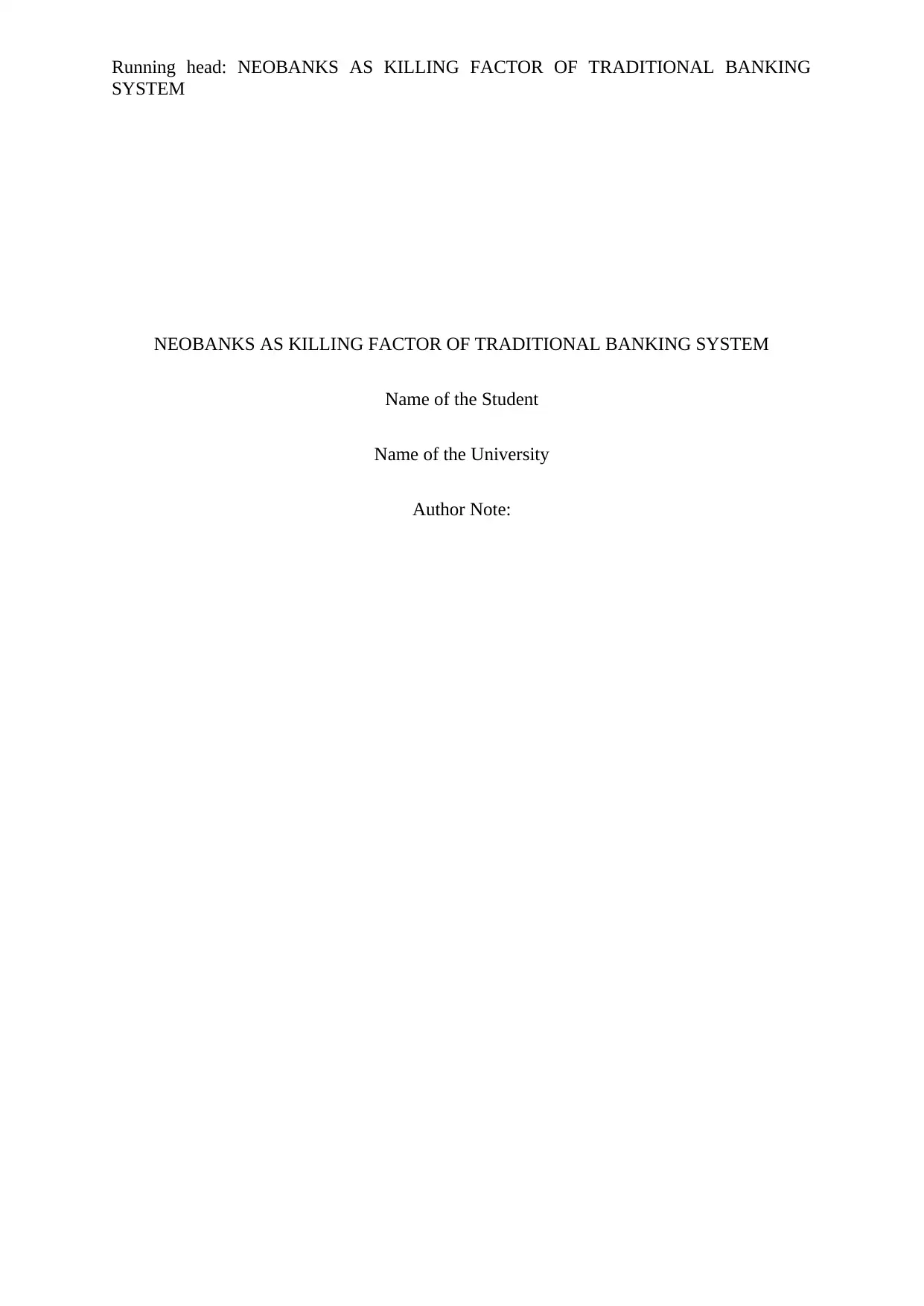
Running head: NEOBANKS AS KILLING FACTOR OF TRADITIONAL BANKING
SYSTEM
NEOBANKS AS KILLING FACTOR OF TRADITIONAL BANKING SYSTEM
Name of the Student
Name of the University
Author Note:
SYSTEM
NEOBANKS AS KILLING FACTOR OF TRADITIONAL BANKING SYSTEM
Name of the Student
Name of the University
Author Note:
Paraphrase This Document
Need a fresh take? Get an instant paraphrase of this document with our AI Paraphraser
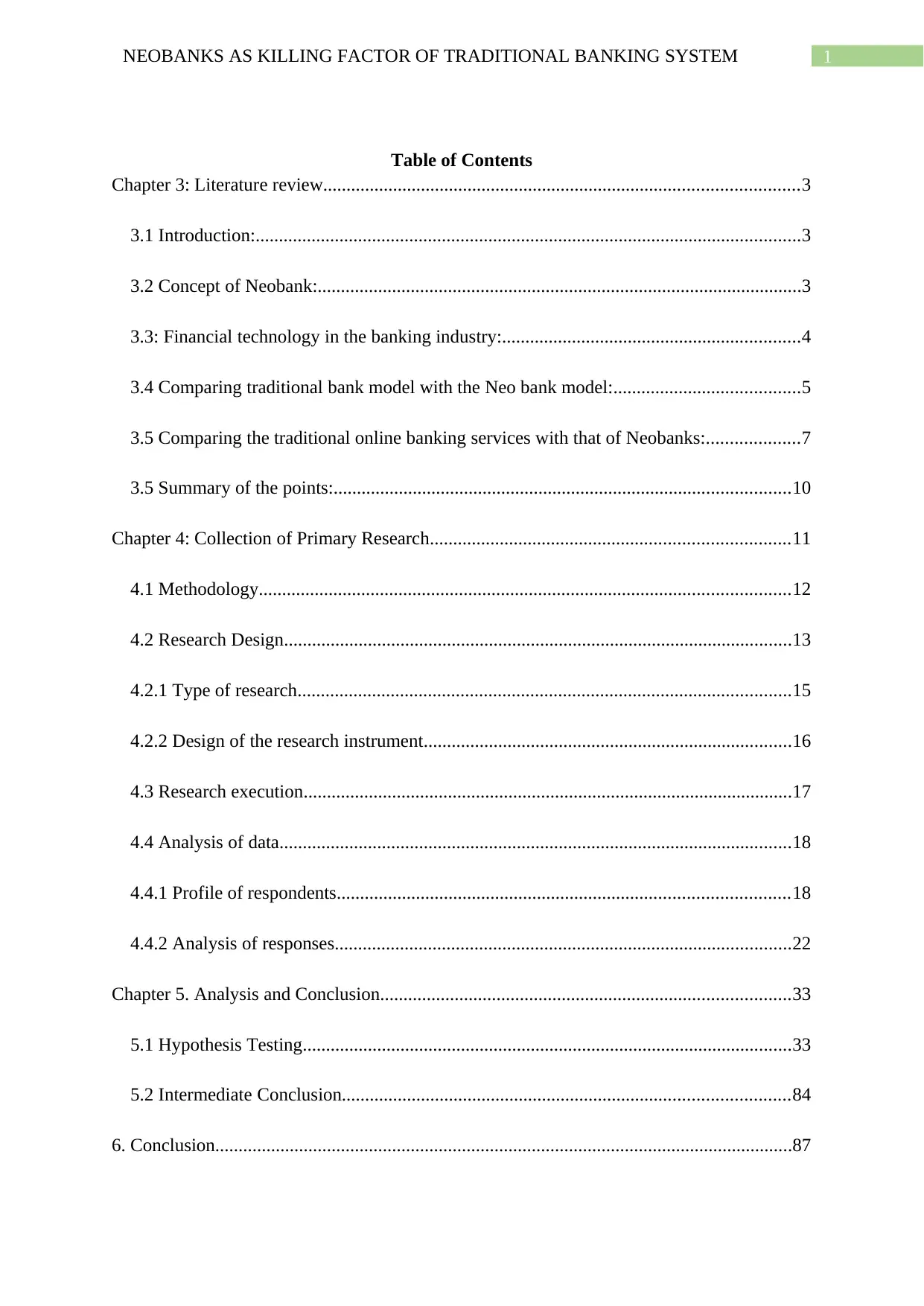
1NEOBANKS AS KILLING FACTOR OF TRADITIONAL BANKING SYSTEM
Table of Contents
Chapter 3: Literature review......................................................................................................3
3.1 Introduction:.....................................................................................................................3
3.2 Concept of Neobank:........................................................................................................3
3.3: Financial technology in the banking industry:................................................................4
3.4 Comparing traditional bank model with the Neo bank model:........................................5
3.5 Comparing the traditional online banking services with that of Neobanks:....................7
3.5 Summary of the points:..................................................................................................10
Chapter 4: Collection of Primary Research.............................................................................11
4.1 Methodology..................................................................................................................12
4.2 Research Design.............................................................................................................13
4.2.1 Type of research..........................................................................................................15
4.2.2 Design of the research instrument...............................................................................16
4.3 Research execution.........................................................................................................17
4.4 Analysis of data..............................................................................................................18
4.4.1 Profile of respondents.................................................................................................18
4.4.2 Analysis of responses..................................................................................................22
Chapter 5. Analysis and Conclusion........................................................................................33
5.1 Hypothesis Testing.........................................................................................................33
5.2 Intermediate Conclusion................................................................................................84
6. Conclusion............................................................................................................................87
Table of Contents
Chapter 3: Literature review......................................................................................................3
3.1 Introduction:.....................................................................................................................3
3.2 Concept of Neobank:........................................................................................................3
3.3: Financial technology in the banking industry:................................................................4
3.4 Comparing traditional bank model with the Neo bank model:........................................5
3.5 Comparing the traditional online banking services with that of Neobanks:....................7
3.5 Summary of the points:..................................................................................................10
Chapter 4: Collection of Primary Research.............................................................................11
4.1 Methodology..................................................................................................................12
4.2 Research Design.............................................................................................................13
4.2.1 Type of research..........................................................................................................15
4.2.2 Design of the research instrument...............................................................................16
4.3 Research execution.........................................................................................................17
4.4 Analysis of data..............................................................................................................18
4.4.1 Profile of respondents.................................................................................................18
4.4.2 Analysis of responses..................................................................................................22
Chapter 5. Analysis and Conclusion........................................................................................33
5.1 Hypothesis Testing.........................................................................................................33
5.2 Intermediate Conclusion................................................................................................84
6. Conclusion............................................................................................................................87
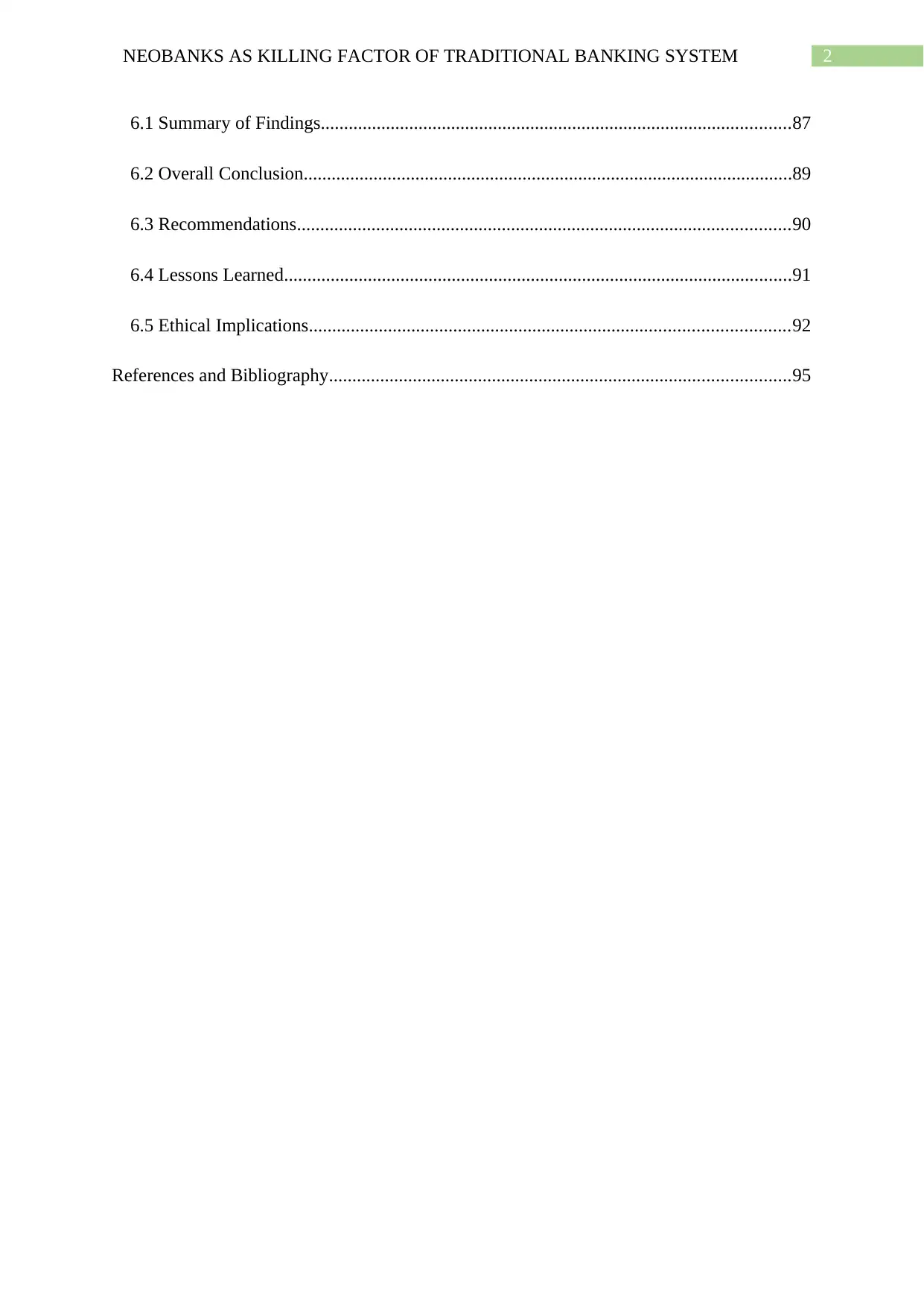
2NEOBANKS AS KILLING FACTOR OF TRADITIONAL BANKING SYSTEM
6.1 Summary of Findings.....................................................................................................87
6.2 Overall Conclusion.........................................................................................................89
6.3 Recommendations..........................................................................................................90
6.4 Lessons Learned.............................................................................................................91
6.5 Ethical Implications.......................................................................................................92
References and Bibliography...................................................................................................95
6.1 Summary of Findings.....................................................................................................87
6.2 Overall Conclusion.........................................................................................................89
6.3 Recommendations..........................................................................................................90
6.4 Lessons Learned.............................................................................................................91
6.5 Ethical Implications.......................................................................................................92
References and Bibliography...................................................................................................95
⊘ This is a preview!⊘
Do you want full access?
Subscribe today to unlock all pages.

Trusted by 1+ million students worldwide

3NEOBANKS AS KILLING FACTOR OF TRADITIONAL BANKING SYSTEM
Chapter 3: Literature review
3.1 Introduction:
This section of the research paper provides a detailed description on the theoretical
background on the concept of Neobank and how the traditional banking system is being
dominated by the trending digital banking system. It also outlines how the business model of
retail banking are challenged by the trending Neobanks. In the last decade, Neobanks have
emerged that are posing challenge to the business model of traditional banking. The
relationship of the customer with then bank is being changed due to the digital revolution
taking place in the 21st century. In the banking sector with a digitized and modernized model,
Neobanks are seeking a foothold which is creating a shift from the customer relationship
model. In many developed countries, the banking sector witnessed a turning point in the
aftermath of the global financial crisis of 2008. The vulnerabilities in the traditional system
of banking system was highlighted by the crisis and resulted in the loss of trusts due to the
public scandals and government bailouts. The last subsection demonstrate the comparison
between the Neobanks with that of traditional online banking system (Moysan & Rudnicki,
2019).
3.2 Concept of Neobank:
A new appearance of the financial world has been built by the FinTech Revolution
after the global financial crisis of 2008 and most the benefits of such revolution has been
reaped by the customers. Despite the fact that the FinTech is in its initial stage, they are
gaining popularity in the financial market as they make use of technology to provide the
financial solutions. Neobank is one such solution that solely offers digital products and
charges lower fees. Such banking system performs most of the transactions using the
applications on the mobile devices and tends to keep the expenses at lower level. In the
Chapter 3: Literature review
3.1 Introduction:
This section of the research paper provides a detailed description on the theoretical
background on the concept of Neobank and how the traditional banking system is being
dominated by the trending digital banking system. It also outlines how the business model of
retail banking are challenged by the trending Neobanks. In the last decade, Neobanks have
emerged that are posing challenge to the business model of traditional banking. The
relationship of the customer with then bank is being changed due to the digital revolution
taking place in the 21st century. In the banking sector with a digitized and modernized model,
Neobanks are seeking a foothold which is creating a shift from the customer relationship
model. In many developed countries, the banking sector witnessed a turning point in the
aftermath of the global financial crisis of 2008. The vulnerabilities in the traditional system
of banking system was highlighted by the crisis and resulted in the loss of trusts due to the
public scandals and government bailouts. The last subsection demonstrate the comparison
between the Neobanks with that of traditional online banking system (Moysan & Rudnicki,
2019).
3.2 Concept of Neobank:
A new appearance of the financial world has been built by the FinTech Revolution
after the global financial crisis of 2008 and most the benefits of such revolution has been
reaped by the customers. Despite the fact that the FinTech is in its initial stage, they are
gaining popularity in the financial market as they make use of technology to provide the
financial solutions. Neobank is one such solution that solely offers digital products and
charges lower fees. Such banking system performs most of the transactions using the
applications on the mobile devices and tends to keep the expenses at lower level. In the
Paraphrase This Document
Need a fresh take? Get an instant paraphrase of this document with our AI Paraphraser

4NEOBANKS AS KILLING FACTOR OF TRADITIONAL BANKING SYSTEM
financial year 2018, the total worth of global market of Neobank stood at USD 18.6 billion
and it is expected that the growth would accelerate at the compounded rate of around 46.5%
and this would generate around USD 394.6 billion by year 2026 (Zaleska & Kondraciuk,
2019). The lower cost model for end customers is substantially driving the growth potential
of Neobanks. Customers under this banking system are charged with either very low or no
monthly fees on the services, withdrawal, deposits and maintenance of minimum balance.
Some of the catalysts for the Neobanks success are the adoption of this banking services by
small and medium and micro enterprises, millennial and due to the embracing of newer
technologies and by those having sporadic earnings and income. The interest of corporates,
venture capitalist and investors has been piqued due to the successful business model and
higher rate of adoption of Neobanks (Collins, 2018). The acceptance of digital payment is
growing in both the organizations and multinational companies and this has caused majority
of the global market revenue of the Neobanks to be accounted by the business sector.
Neobank are the fully digital direct bank and are owned independently. The two most
established Neobanks is Monzo in Germany and United Kingdom.
3.3: Financial technology in the banking industry:
Significant changes is being experienced by the banking sector due to various factors
such as shift in the expectations of the customers, digitization and regulatory changes. With
the rise of new platform of payments and Neobank, banking is not about just directly paying
the debit and paying off the credit cards at the month end. The manner in which people
receive and make payments are transformed with the Neobanks representing the new age of
banking revolution. Neobanks and challenger banks are the two major groups of FinTech
banks. Neobanks are the mobile or internet banking focuses on the niche market and offers
individual customer with the customized services. On other hand, Challenger bank are same
as the traditional banks that do not rely on other banks and have its own infrastructure. Both
financial year 2018, the total worth of global market of Neobank stood at USD 18.6 billion
and it is expected that the growth would accelerate at the compounded rate of around 46.5%
and this would generate around USD 394.6 billion by year 2026 (Zaleska & Kondraciuk,
2019). The lower cost model for end customers is substantially driving the growth potential
of Neobanks. Customers under this banking system are charged with either very low or no
monthly fees on the services, withdrawal, deposits and maintenance of minimum balance.
Some of the catalysts for the Neobanks success are the adoption of this banking services by
small and medium and micro enterprises, millennial and due to the embracing of newer
technologies and by those having sporadic earnings and income. The interest of corporates,
venture capitalist and investors has been piqued due to the successful business model and
higher rate of adoption of Neobanks (Collins, 2018). The acceptance of digital payment is
growing in both the organizations and multinational companies and this has caused majority
of the global market revenue of the Neobanks to be accounted by the business sector.
Neobank are the fully digital direct bank and are owned independently. The two most
established Neobanks is Monzo in Germany and United Kingdom.
3.3: Financial technology in the banking industry:
Significant changes is being experienced by the banking sector due to various factors
such as shift in the expectations of the customers, digitization and regulatory changes. With
the rise of new platform of payments and Neobank, banking is not about just directly paying
the debit and paying off the credit cards at the month end. The manner in which people
receive and make payments are transformed with the Neobanks representing the new age of
banking revolution. Neobanks and challenger banks are the two major groups of FinTech
banks. Neobanks are the mobile or internet banking focuses on the niche market and offers
individual customer with the customized services. On other hand, Challenger bank are same
as the traditional banks that do not rely on other banks and have its own infrastructure. Both
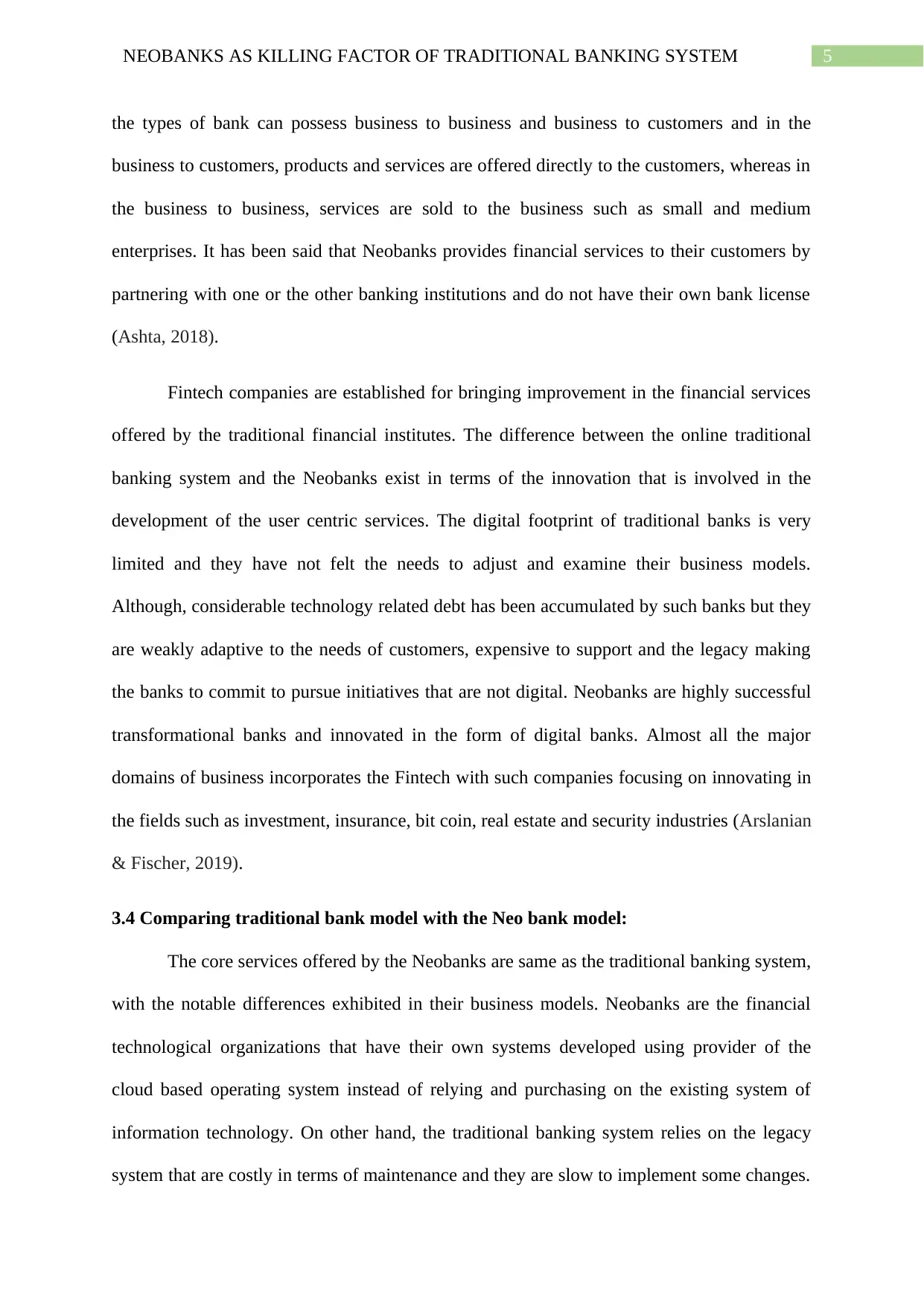
5NEOBANKS AS KILLING FACTOR OF TRADITIONAL BANKING SYSTEM
the types of bank can possess business to business and business to customers and in the
business to customers, products and services are offered directly to the customers, whereas in
the business to business, services are sold to the business such as small and medium
enterprises. It has been said that Neobanks provides financial services to their customers by
partnering with one or the other banking institutions and do not have their own bank license
(Ashta, 2018).
Fintech companies are established for bringing improvement in the financial services
offered by the traditional financial institutes. The difference between the online traditional
banking system and the Neobanks exist in terms of the innovation that is involved in the
development of the user centric services. The digital footprint of traditional banks is very
limited and they have not felt the needs to adjust and examine their business models.
Although, considerable technology related debt has been accumulated by such banks but they
are weakly adaptive to the needs of customers, expensive to support and the legacy making
the banks to commit to pursue initiatives that are not digital. Neobanks are highly successful
transformational banks and innovated in the form of digital banks. Almost all the major
domains of business incorporates the Fintech with such companies focusing on innovating in
the fields such as investment, insurance, bit coin, real estate and security industries (Arslanian
& Fischer, 2019).
3.4 Comparing traditional bank model with the Neo bank model:
The core services offered by the Neobanks are same as the traditional banking system,
with the notable differences exhibited in their business models. Neobanks are the financial
technological organizations that have their own systems developed using provider of the
cloud based operating system instead of relying and purchasing on the existing system of
information technology. On other hand, the traditional banking system relies on the legacy
system that are costly in terms of maintenance and they are slow to implement some changes.
the types of bank can possess business to business and business to customers and in the
business to customers, products and services are offered directly to the customers, whereas in
the business to business, services are sold to the business such as small and medium
enterprises. It has been said that Neobanks provides financial services to their customers by
partnering with one or the other banking institutions and do not have their own bank license
(Ashta, 2018).
Fintech companies are established for bringing improvement in the financial services
offered by the traditional financial institutes. The difference between the online traditional
banking system and the Neobanks exist in terms of the innovation that is involved in the
development of the user centric services. The digital footprint of traditional banks is very
limited and they have not felt the needs to adjust and examine their business models.
Although, considerable technology related debt has been accumulated by such banks but they
are weakly adaptive to the needs of customers, expensive to support and the legacy making
the banks to commit to pursue initiatives that are not digital. Neobanks are highly successful
transformational banks and innovated in the form of digital banks. Almost all the major
domains of business incorporates the Fintech with such companies focusing on innovating in
the fields such as investment, insurance, bit coin, real estate and security industries (Arslanian
& Fischer, 2019).
3.4 Comparing traditional bank model with the Neo bank model:
The core services offered by the Neobanks are same as the traditional banking system,
with the notable differences exhibited in their business models. Neobanks are the financial
technological organizations that have their own systems developed using provider of the
cloud based operating system instead of relying and purchasing on the existing system of
information technology. On other hand, the traditional banking system relies on the legacy
system that are costly in terms of maintenance and they are slow to implement some changes.
⊘ This is a preview!⊘
Do you want full access?
Subscribe today to unlock all pages.

Trusted by 1+ million students worldwide
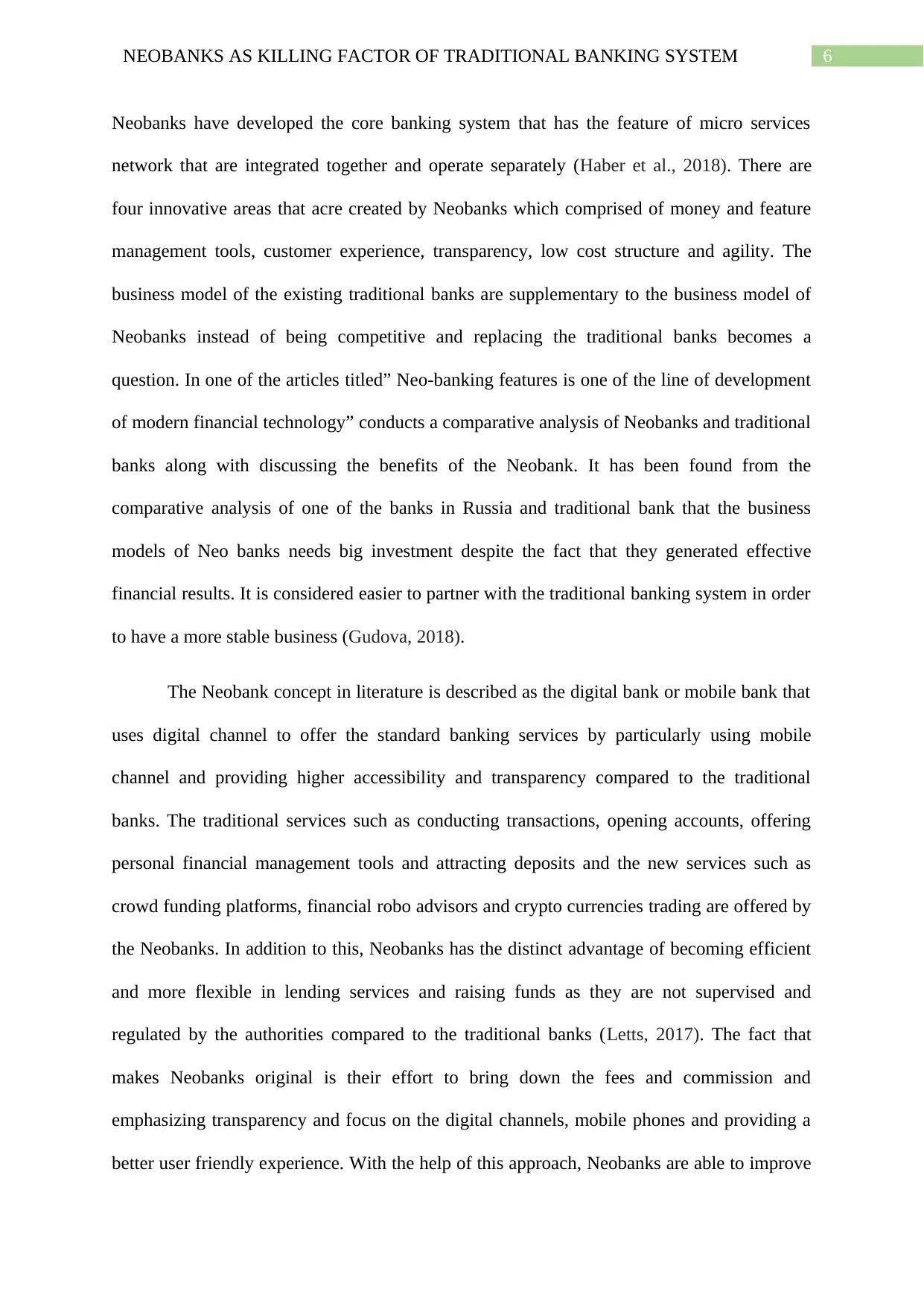
6NEOBANKS AS KILLING FACTOR OF TRADITIONAL BANKING SYSTEM
Neobanks have developed the core banking system that has the feature of micro services
network that are integrated together and operate separately (Haber et al., 2018). There are
four innovative areas that acre created by Neobanks which comprised of money and feature
management tools, customer experience, transparency, low cost structure and agility. The
business model of the existing traditional banks are supplementary to the business model of
Neobanks instead of being competitive and replacing the traditional banks becomes a
question. In one of the articles titled” Neo-banking features is one of the line of development
of modern financial technology” conducts a comparative analysis of Neobanks and traditional
banks along with discussing the benefits of the Neobank. It has been found from the
comparative analysis of one of the banks in Russia and traditional bank that the business
models of Neo banks needs big investment despite the fact that they generated effective
financial results. It is considered easier to partner with the traditional banking system in order
to have a more stable business (Gudova, 2018).
The Neobank concept in literature is described as the digital bank or mobile bank that
uses digital channel to offer the standard banking services by particularly using mobile
channel and providing higher accessibility and transparency compared to the traditional
banks. The traditional services such as conducting transactions, opening accounts, offering
personal financial management tools and attracting deposits and the new services such as
crowd funding platforms, financial robo advisors and crypto currencies trading are offered by
the Neobanks. In addition to this, Neobanks has the distinct advantage of becoming efficient
and more flexible in lending services and raising funds as they are not supervised and
regulated by the authorities compared to the traditional banks (Letts, 2017). The fact that
makes Neobanks original is their effort to bring down the fees and commission and
emphasizing transparency and focus on the digital channels, mobile phones and providing a
better user friendly experience. With the help of this approach, Neobanks are able to improve
Neobanks have developed the core banking system that has the feature of micro services
network that are integrated together and operate separately (Haber et al., 2018). There are
four innovative areas that acre created by Neobanks which comprised of money and feature
management tools, customer experience, transparency, low cost structure and agility. The
business model of the existing traditional banks are supplementary to the business model of
Neobanks instead of being competitive and replacing the traditional banks becomes a
question. In one of the articles titled” Neo-banking features is one of the line of development
of modern financial technology” conducts a comparative analysis of Neobanks and traditional
banks along with discussing the benefits of the Neobank. It has been found from the
comparative analysis of one of the banks in Russia and traditional bank that the business
models of Neo banks needs big investment despite the fact that they generated effective
financial results. It is considered easier to partner with the traditional banking system in order
to have a more stable business (Gudova, 2018).
The Neobank concept in literature is described as the digital bank or mobile bank that
uses digital channel to offer the standard banking services by particularly using mobile
channel and providing higher accessibility and transparency compared to the traditional
banks. The traditional services such as conducting transactions, opening accounts, offering
personal financial management tools and attracting deposits and the new services such as
crowd funding platforms, financial robo advisors and crypto currencies trading are offered by
the Neobanks. In addition to this, Neobanks has the distinct advantage of becoming efficient
and more flexible in lending services and raising funds as they are not supervised and
regulated by the authorities compared to the traditional banks (Letts, 2017). The fact that
makes Neobanks original is their effort to bring down the fees and commission and
emphasizing transparency and focus on the digital channels, mobile phones and providing a
better user friendly experience. With the help of this approach, Neobanks are able to improve
Paraphrase This Document
Need a fresh take? Get an instant paraphrase of this document with our AI Paraphraser

7NEOBANKS AS KILLING FACTOR OF TRADITIONAL BANKING SYSTEM
their services by catering to the needs of customers and building up loyalty and obtaining
feedback and data. There has been increase in the number of online banking and mobile users
due to increase in informatization and computerization. Another article titled” Achieving
Competition in the Financial Sector” have found that the entrance of the Neobanks in the
financial market of Europe have disrupted the model of traditional business in the financial
sector. The introduction of customer centric area and forces introduced by the digital
disruption have weakened the traditional business model (Boss et al., 2019).
3.5 Comparing the traditional online banking services with that of Neobanks:
The traditional banking system has been revolutionized by the introduction of
electronic banking system with the help of which greatest expediency is provided to the
customers in performing banking transactions. There exist fundamental difference between
Neobanks and traditional bank as the former operates digitally either through the mobile app
or internet and the latter operates through the physical branches with the options of online
banking services. The status quo of the established traditional banks is directly challenged by
the Neobanks due to its hyper personal customer experience and lower cost. Neobanks have
various benefits due to the absence of complicated organizational structure, legacy system
and heavy regulatory requirements. However, its acceptance in the market is somewhat
difficult due to its focus on the segments of niche customers and millennial as they are likely
to be keen on the tech savvy and gig economy. The flexible nature of this particular segment
of customer is supported by offering the necessary financial solutions (Okunevych &
Hlivecka, 2018). Unique banking services are offered by the Neobanks startup located in
United States that encompasses zero interest rate and flat fee credit facilities to freelancers.
Fintech companies such as Neobanks do not only have information technology as the factor
of differentiation but they strives for streamlining process and offering efficient services. It is
important for identifying the distinction between new disruptive entrants such as Neobanks
their services by catering to the needs of customers and building up loyalty and obtaining
feedback and data. There has been increase in the number of online banking and mobile users
due to increase in informatization and computerization. Another article titled” Achieving
Competition in the Financial Sector” have found that the entrance of the Neobanks in the
financial market of Europe have disrupted the model of traditional business in the financial
sector. The introduction of customer centric area and forces introduced by the digital
disruption have weakened the traditional business model (Boss et al., 2019).
3.5 Comparing the traditional online banking services with that of Neobanks:
The traditional banking system has been revolutionized by the introduction of
electronic banking system with the help of which greatest expediency is provided to the
customers in performing banking transactions. There exist fundamental difference between
Neobanks and traditional bank as the former operates digitally either through the mobile app
or internet and the latter operates through the physical branches with the options of online
banking services. The status quo of the established traditional banks is directly challenged by
the Neobanks due to its hyper personal customer experience and lower cost. Neobanks have
various benefits due to the absence of complicated organizational structure, legacy system
and heavy regulatory requirements. However, its acceptance in the market is somewhat
difficult due to its focus on the segments of niche customers and millennial as they are likely
to be keen on the tech savvy and gig economy. The flexible nature of this particular segment
of customer is supported by offering the necessary financial solutions (Okunevych &
Hlivecka, 2018). Unique banking services are offered by the Neobanks startup located in
United States that encompasses zero interest rate and flat fee credit facilities to freelancers.
Fintech companies such as Neobanks do not only have information technology as the factor
of differentiation but they strives for streamlining process and offering efficient services. It is
important for identifying the distinction between new disruptive entrants such as Neobanks

8NEOBANKS AS KILLING FACTOR OF TRADITIONAL BANKING SYSTEM
and traditional banks as the banking sector digitization are already impacted by the Fintech
companies (Molnár, 2018).
Neobanks have targeted lending practices of traditional banking system because of
decreasing information asymmetry, efficiency and cost. Gathering of information between
the lender and borrower can be improved by reducing distance between them that forms a
crucial part of lending practice. Neobanks identified the opportunities of building a
community of borrowers and lenders and this made the innovation of crowd funding model of
business. Individuals lacking funds are benefitted by this crowd fund lending as they can
access the capital at the reasonable rate of interest and thereby lenders are provided with
streams of revenue and tacking of lending in the modular fashion is the competitive edge
when competing with other financial institutions (Lau & Leimer, 2019).
Over the traditional banking system, Neobanks are enjoying various advantages.
Firstly, these banks driven by innovation do not rely on the core legacy system and such
system tends to impose a heavy burden on innovating as the underlying infrastructure and
core functionality is becoming obsolete. However, there exist barrier to innovation due to the
operational risk on incumbents and the fact that change in the infrastructure and legacy
system is costly. The major driver of the success of the Neobanks is because the business
model is driven by technology which requires them to heavily invest in building core
competencies, programing capabilities and development of software. On contrary to this,
traditional banks do not possess the ability of promptly respond and make modifications. The
misconduct and lack of transparency in the traditional banking during the great recession that
significantly damage the trust of public. Neobanks took the opportunity of public
disappointment and gained the market share over other banks rapidly (Hopkinson et al.,
2019). They brought more user centric innovation and provided better services to the
customers. It is indicated by one of the Pwc reports published that the entrance of Fintech
and traditional banks as the banking sector digitization are already impacted by the Fintech
companies (Molnár, 2018).
Neobanks have targeted lending practices of traditional banking system because of
decreasing information asymmetry, efficiency and cost. Gathering of information between
the lender and borrower can be improved by reducing distance between them that forms a
crucial part of lending practice. Neobanks identified the opportunities of building a
community of borrowers and lenders and this made the innovation of crowd funding model of
business. Individuals lacking funds are benefitted by this crowd fund lending as they can
access the capital at the reasonable rate of interest and thereby lenders are provided with
streams of revenue and tacking of lending in the modular fashion is the competitive edge
when competing with other financial institutions (Lau & Leimer, 2019).
Over the traditional banking system, Neobanks are enjoying various advantages.
Firstly, these banks driven by innovation do not rely on the core legacy system and such
system tends to impose a heavy burden on innovating as the underlying infrastructure and
core functionality is becoming obsolete. However, there exist barrier to innovation due to the
operational risk on incumbents and the fact that change in the infrastructure and legacy
system is costly. The major driver of the success of the Neobanks is because the business
model is driven by technology which requires them to heavily invest in building core
competencies, programing capabilities and development of software. On contrary to this,
traditional banks do not possess the ability of promptly respond and make modifications. The
misconduct and lack of transparency in the traditional banking during the great recession that
significantly damage the trust of public. Neobanks took the opportunity of public
disappointment and gained the market share over other banks rapidly (Hopkinson et al.,
2019). They brought more user centric innovation and provided better services to the
customers. It is indicated by one of the Pwc reports published that the entrance of Fintech
⊘ This is a preview!⊘
Do you want full access?
Subscribe today to unlock all pages.

Trusted by 1+ million students worldwide
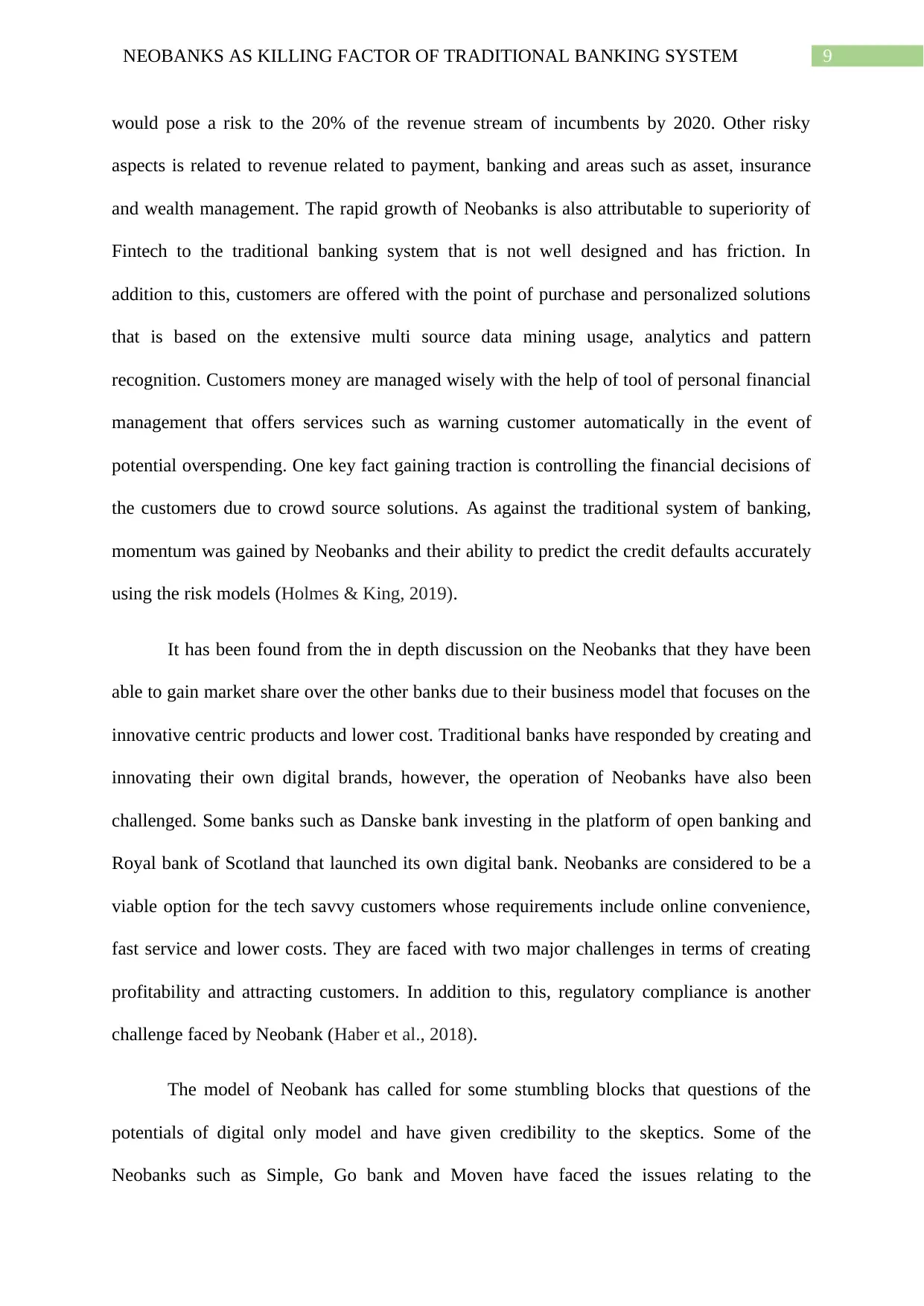
9NEOBANKS AS KILLING FACTOR OF TRADITIONAL BANKING SYSTEM
would pose a risk to the 20% of the revenue stream of incumbents by 2020. Other risky
aspects is related to revenue related to payment, banking and areas such as asset, insurance
and wealth management. The rapid growth of Neobanks is also attributable to superiority of
Fintech to the traditional banking system that is not well designed and has friction. In
addition to this, customers are offered with the point of purchase and personalized solutions
that is based on the extensive multi source data mining usage, analytics and pattern
recognition. Customers money are managed wisely with the help of tool of personal financial
management that offers services such as warning customer automatically in the event of
potential overspending. One key fact gaining traction is controlling the financial decisions of
the customers due to crowd source solutions. As against the traditional system of banking,
momentum was gained by Neobanks and their ability to predict the credit defaults accurately
using the risk models (Holmes & King, 2019).
It has been found from the in depth discussion on the Neobanks that they have been
able to gain market share over the other banks due to their business model that focuses on the
innovative centric products and lower cost. Traditional banks have responded by creating and
innovating their own digital brands, however, the operation of Neobanks have also been
challenged. Some banks such as Danske bank investing in the platform of open banking and
Royal bank of Scotland that launched its own digital bank. Neobanks are considered to be a
viable option for the tech savvy customers whose requirements include online convenience,
fast service and lower costs. They are faced with two major challenges in terms of creating
profitability and attracting customers. In addition to this, regulatory compliance is another
challenge faced by Neobank (Haber et al., 2018).
The model of Neobank has called for some stumbling blocks that questions of the
potentials of digital only model and have given credibility to the skeptics. Some of the
Neobanks such as Simple, Go bank and Moven have faced the issues relating to the
would pose a risk to the 20% of the revenue stream of incumbents by 2020. Other risky
aspects is related to revenue related to payment, banking and areas such as asset, insurance
and wealth management. The rapid growth of Neobanks is also attributable to superiority of
Fintech to the traditional banking system that is not well designed and has friction. In
addition to this, customers are offered with the point of purchase and personalized solutions
that is based on the extensive multi source data mining usage, analytics and pattern
recognition. Customers money are managed wisely with the help of tool of personal financial
management that offers services such as warning customer automatically in the event of
potential overspending. One key fact gaining traction is controlling the financial decisions of
the customers due to crowd source solutions. As against the traditional system of banking,
momentum was gained by Neobanks and their ability to predict the credit defaults accurately
using the risk models (Holmes & King, 2019).
It has been found from the in depth discussion on the Neobanks that they have been
able to gain market share over the other banks due to their business model that focuses on the
innovative centric products and lower cost. Traditional banks have responded by creating and
innovating their own digital brands, however, the operation of Neobanks have also been
challenged. Some banks such as Danske bank investing in the platform of open banking and
Royal bank of Scotland that launched its own digital bank. Neobanks are considered to be a
viable option for the tech savvy customers whose requirements include online convenience,
fast service and lower costs. They are faced with two major challenges in terms of creating
profitability and attracting customers. In addition to this, regulatory compliance is another
challenge faced by Neobank (Haber et al., 2018).
The model of Neobank has called for some stumbling blocks that questions of the
potentials of digital only model and have given credibility to the skeptics. Some of the
Neobanks such as Simple, Go bank and Moven have faced the issues relating to the
Paraphrase This Document
Need a fresh take? Get an instant paraphrase of this document with our AI Paraphraser
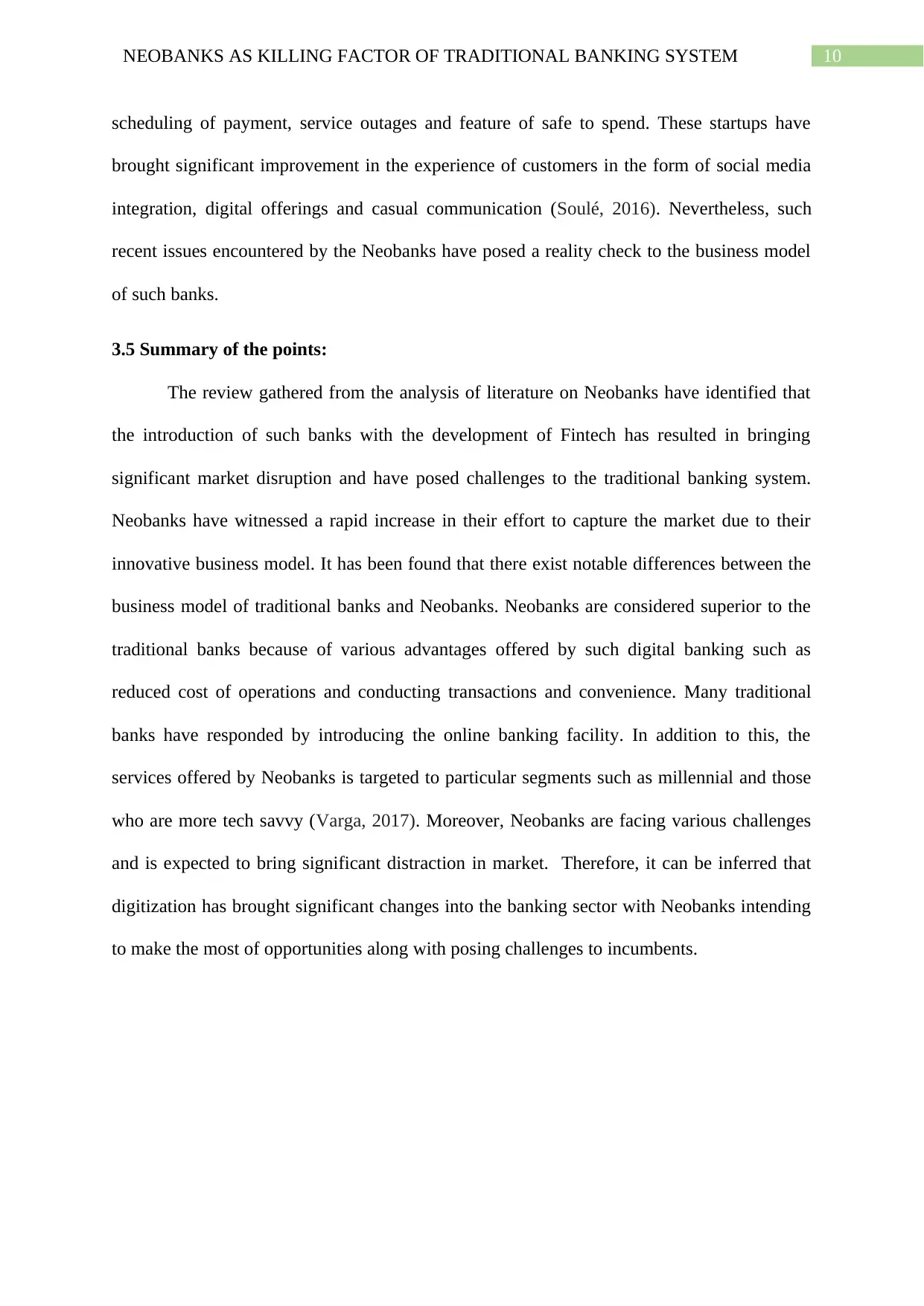
10NEOBANKS AS KILLING FACTOR OF TRADITIONAL BANKING SYSTEM
scheduling of payment, service outages and feature of safe to spend. These startups have
brought significant improvement in the experience of customers in the form of social media
integration, digital offerings and casual communication (Soulé, 2016). Nevertheless, such
recent issues encountered by the Neobanks have posed a reality check to the business model
of such banks.
3.5 Summary of the points:
The review gathered from the analysis of literature on Neobanks have identified that
the introduction of such banks with the development of Fintech has resulted in bringing
significant market disruption and have posed challenges to the traditional banking system.
Neobanks have witnessed a rapid increase in their effort to capture the market due to their
innovative business model. It has been found that there exist notable differences between the
business model of traditional banks and Neobanks. Neobanks are considered superior to the
traditional banks because of various advantages offered by such digital banking such as
reduced cost of operations and conducting transactions and convenience. Many traditional
banks have responded by introducing the online banking facility. In addition to this, the
services offered by Neobanks is targeted to particular segments such as millennial and those
who are more tech savvy (Varga, 2017). Moreover, Neobanks are facing various challenges
and is expected to bring significant distraction in market. Therefore, it can be inferred that
digitization has brought significant changes into the banking sector with Neobanks intending
to make the most of opportunities along with posing challenges to incumbents.
scheduling of payment, service outages and feature of safe to spend. These startups have
brought significant improvement in the experience of customers in the form of social media
integration, digital offerings and casual communication (Soulé, 2016). Nevertheless, such
recent issues encountered by the Neobanks have posed a reality check to the business model
of such banks.
3.5 Summary of the points:
The review gathered from the analysis of literature on Neobanks have identified that
the introduction of such banks with the development of Fintech has resulted in bringing
significant market disruption and have posed challenges to the traditional banking system.
Neobanks have witnessed a rapid increase in their effort to capture the market due to their
innovative business model. It has been found that there exist notable differences between the
business model of traditional banks and Neobanks. Neobanks are considered superior to the
traditional banks because of various advantages offered by such digital banking such as
reduced cost of operations and conducting transactions and convenience. Many traditional
banks have responded by introducing the online banking facility. In addition to this, the
services offered by Neobanks is targeted to particular segments such as millennial and those
who are more tech savvy (Varga, 2017). Moreover, Neobanks are facing various challenges
and is expected to bring significant distraction in market. Therefore, it can be inferred that
digitization has brought significant changes into the banking sector with Neobanks intending
to make the most of opportunities along with posing challenges to incumbents.
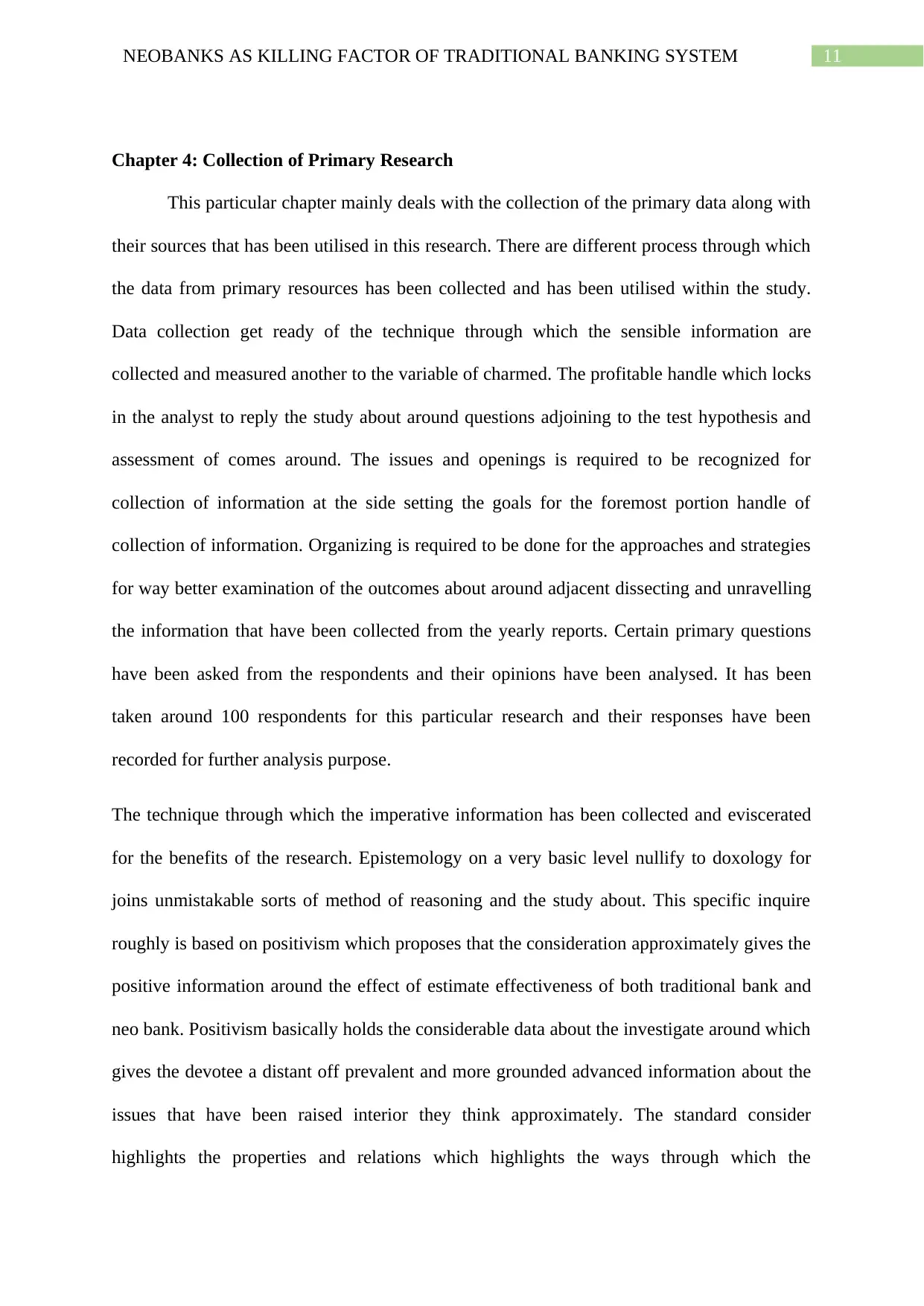
11NEOBANKS AS KILLING FACTOR OF TRADITIONAL BANKING SYSTEM
Chapter 4: Collection of Primary Research
This particular chapter mainly deals with the collection of the primary data along with
their sources that has been utilised in this research. There are different process through which
the data from primary resources has been collected and has been utilised within the study.
Data collection get ready of the technique through which the sensible information are
collected and measured another to the variable of charmed. The profitable handle which locks
in the analyst to reply the study about around questions adjoining to the test hypothesis and
assessment of comes around. The issues and openings is required to be recognized for
collection of information at the side setting the goals for the foremost portion handle of
collection of information. Organizing is required to be done for the approaches and strategies
for way better examination of the outcomes about around adjacent dissecting and unravelling
the information that have been collected from the yearly reports. Certain primary questions
have been asked from the respondents and their opinions have been analysed. It has been
taken around 100 respondents for this particular research and their responses have been
recorded for further analysis purpose.
The technique through which the imperative information has been collected and eviscerated
for the benefits of the research. Epistemology on a very basic level nullify to doxology for
joins unmistakable sorts of method of reasoning and the study about. This specific inquire
roughly is based on positivism which proposes that the consideration approximately gives the
positive information around the effect of estimate effectiveness of both traditional bank and
neo bank. Positivism basically holds the considerable data about the investigate around which
gives the devotee a distant off prevalent and more grounded advanced information about the
issues that have been raised interior they think approximately. The standard consider
highlights the properties and relations which highlights the ways through which the
Chapter 4: Collection of Primary Research
This particular chapter mainly deals with the collection of the primary data along with
their sources that has been utilised in this research. There are different process through which
the data from primary resources has been collected and has been utilised within the study.
Data collection get ready of the technique through which the sensible information are
collected and measured another to the variable of charmed. The profitable handle which locks
in the analyst to reply the study about around questions adjoining to the test hypothesis and
assessment of comes around. The issues and openings is required to be recognized for
collection of information at the side setting the goals for the foremost portion handle of
collection of information. Organizing is required to be done for the approaches and strategies
for way better examination of the outcomes about around adjacent dissecting and unravelling
the information that have been collected from the yearly reports. Certain primary questions
have been asked from the respondents and their opinions have been analysed. It has been
taken around 100 respondents for this particular research and their responses have been
recorded for further analysis purpose.
The technique through which the imperative information has been collected and eviscerated
for the benefits of the research. Epistemology on a very basic level nullify to doxology for
joins unmistakable sorts of method of reasoning and the study about. This specific inquire
roughly is based on positivism which proposes that the consideration approximately gives the
positive information around the effect of estimate effectiveness of both traditional bank and
neo bank. Positivism basically holds the considerable data about the investigate around which
gives the devotee a distant off prevalent and more grounded advanced information about the
issues that have been raised interior they think approximately. The standard consider
highlights the properties and relations which highlights the ways through which the
⊘ This is a preview!⊘
Do you want full access?
Subscribe today to unlock all pages.

Trusted by 1+ million students worldwide
1 out of 107
Related Documents
Your All-in-One AI-Powered Toolkit for Academic Success.
+13062052269
info@desklib.com
Available 24*7 on WhatsApp / Email
![[object Object]](/_next/static/media/star-bottom.7253800d.svg)
Unlock your academic potential
Copyright © 2020–2025 A2Z Services. All Rights Reserved. Developed and managed by ZUCOL.





